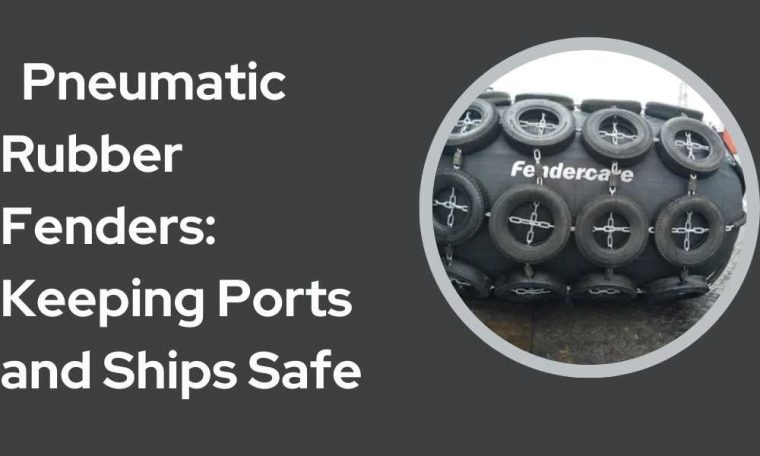
When it comes to maritime safety, one crucial component that often goes unnoticed but plays a vital role in protecting both ships and ports is the Pneumatic Rubber Fender. In this article, we will delve into the world of these ingenious devices, breaking down their functionality, importance, and various applications. By the end, you’ll have a comprehensive understanding of what Pneumatic Rubber Fenders are and why they are crucial for the maritime industry.
What Is a Pneumatic Rubber Fender?
A Pneumatic Rubber Fender, at its core, serves as a simple yet highly effective maritime safety device designed to prevent damage when ships and boats make contact with docks, other vessels, or offshore structures. Think of them as giant, inflatable cushions for ships. These fenders are typically cylindrical in shape and consist of an outer rubber layer and an inner air chamber.
How Do Pneumatic Rubber Fenders Work?
Pneumatic Rubber Fenders operate on a straightforward principle – when a vessel makes contact with them, they compress, absorbing the kinetic energy of the impact and reducing the force exerted on both the ship and the structure they’re protecting. The inner air chamber provides the necessary buoyancy and elasticity, allowing the fender to deform and absorb the shock.
The Key Components
Understanding the components of a Pneumatic Rubber Fender is crucial to grasp its functionality fully:
- Outer Rubber Layer: The outer layer of the fender is made of high-quality, abrasion-resistant rubber. This layer serves as a protective shield against external forces and provides durability.
- Inner Air Chamber: The heart of the fender is the inner air chamber, which is filled with air at a specified pressure. This chamber is what allows the fender to inflate and deflate as needed to absorb impact energy.
- End Flanges: The fender’s two ends are equipped with steel flanges, which are used for attachment to the structure it’s protecting. These flanges are integral in ensuring the fender stays in place during an impact.
Applications of Pneumatic Rubber Fenders
Pneumatic Rubber Fenders are versatile maritime safety devices with a wide range of applications. Their ability to absorb impact energy and reduce the risk of damage makes them indispensable in various maritime scenarios. Here are some key applications of Pneumatic Rubber Fenders:
- Ship-to-Ship Transfers: Pneumatic Rubber Fenders are commonly used during ship-to-ship transfers. When two vessels come alongside each other for cargo or personnel transfer, these fenders act as a cushion, preventing collisions and ensuring a safe transfer process. Whether it’s an oil tanker or a cargo ship, Pneumatic Rubber Fenders play a crucial role in maintaining the integrity of both vessels involved.
- Ship-to-Dock Berthing: One of the primary applications of Pneumatic Rubber Fenders is in ship-to-dock berthing. When a ship docks at a port or terminal, these fenders are positioned between the vessel and the dock structure. They absorb the kinetic energy generated during the berthing process, preventing damage to the ship’s hull and the dock itself. This application is vital for maintaining port infrastructure and ensuring the safe arrival and departure of ships.
- Offshore Platforms: Offshore oil platforms and other structures in the open sea are vulnerable to collisions with passing vessels. Pneumatic Rubber Fenders provide a protective barrier around these platforms, reducing the risk of accidental impact. By absorbing the energy of collisions, they safeguard both the offshore structure and the vessels navigating nearby.
- Floating Structures: Pneumatic Rubber Fenders are also used in floating structures such as floating docks, pontoons, and barges. These fenders help absorb the forces generated when these structures come into contact with ships, preventing damage and ensuring the stability of the floating platforms. This application is essential in various marine industries, including marinas and waterfront facilities.
- Harbor and Canal Protection: In addition to safeguarding ships and offshore structures, Pneumatic Rubber Fenders are employed to protect harbor walls, quays, and canal edges. By reducing the impact force of vessels maneuvering in narrow waterways. These fenders prevent structural damage and maintain the integrity of vital water transport infrastructure.
- Military and Defense: Pneumatic Rubber Fenders also find applications in military and defense operations. They are used during naval operations, including ship-to-ship transfers, to ensure the safety of personnel and equipment. Additionally, these fenders play a role in protecting military installations, such as naval bases and coastal defenses.
Advantages of Pneumatic Rubber Fenders
Now that we’ve covered the basics, let’s explore the advantages that make Pneumatic Rubber Fenders the preferred choice in many maritime applications:
- Excellent Energy Absorption: Pneumatic Rubber Fenders have a remarkable ability to absorb kinetic energy, making them highly effective in reducing impact forces during collisions.
- Low Reaction Force: These fenders exert minimal reaction force on the contacting vessel, reducing the risk of damage to both the ship and the structure.
- Versatility: Pneumatic Rubber Fenders can be used in various maritime scenarios, from small boats to large vessels, and in diverse environmental conditions.
- Durability: With their robust construction using high-quality rubber and steel components, these fenders have a long service life, even in harsh marine environments.
- Easy Maintenance: Maintenance requirements for Pneumatic Rubber Fenders are relatively low, making them a cost-effective choice for port authorities and vessel operators.
Selecting the Right Pneumatic Rubber Fender
Choosing the right type and size of Pneumatic Rubber Fender is crucial for its effectiveness. Here are some factors to consider when selecting one:
- Vessel Size: The size of the vessel using the fender plays a significant role in determining the fender’s dimensions and capacity to absorb impact.
- Berthing Energy: Calculating the maximum berthing energy the fender will need to absorb helps in choosing the appropriate fender size and pressure.
- Environmental Conditions: Consider the environmental factors, such as tidal variations and weather conditions, to ensure the fender can perform optimally under different circumstances.
Conclusion
In summary, Pneumatic Rubber Fenders are unsung heroes of the maritime industry. Providing a vital layer of protection for ships, ports, and offshore structures. Their ability to absorb energy and reduce the risk of damage during collisions makes them indispensable for ensuring safe and efficient maritime operations.
Understanding the components and advantages of Pneumatic Rubber Fenders can help port authorities. Vessel operators, and maritime engineers make informed decisions when it comes to selecting the right fenders for their specific needs. With their durability, versatility, and cost-effectiveness, these fenders continue to play a crucial role in keeping our ports and ships safe.
Note: This article www.subsellkaro.com should have given you a certain idea about Pneumatic Rubber Fender.



